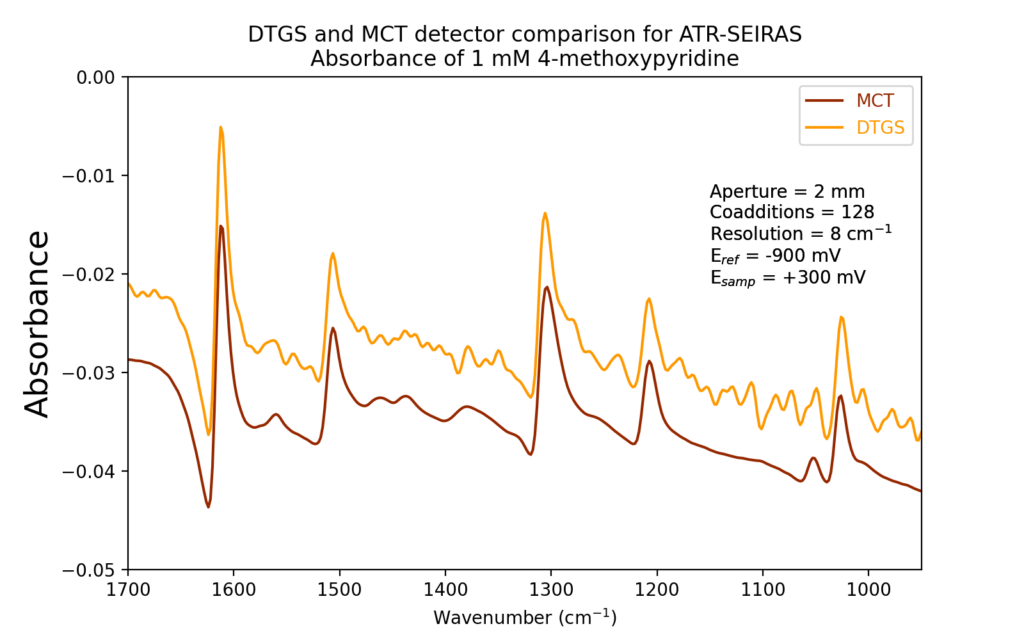Having a hard time deciding which Jackfish cell is most suitable for your research? The table below provides a high-level comparison of the four main spectroelectrochemical cells offered by Jackfish.
Category: Uncategorized
DTGS detectors for ATR-SEIRAS
We always recommend using a liquid nitrogen-cooled MCT detector for ATR-SEIRAS if available. If a MCT detector is not available, a room-temperature DTGS detector may be acceptable. A large number of co-added scans are required to achieve an acceptable signal-to-noise ratio, so the main consideration is the stability of the experimental system over the time required to collect the scans.
Here are two potential-difference absorption spectra comparing the performance of a DTGS detector to a MCT detector:

Experimental
An intrinsic, float-zone Si 35° microgrooved wafer was sputtered with 15 nm of indium tin oxide (ITO) and thermally annealed under vacuum at 300 °C for 1 hour. A gold nanoparticle film was electrodeposited onto the ITO film by applying a constant potential of -500 mV (vs sat. Ag/AgCl) and measuring the current until 5 mC of charge was delivered. The electrodeposition solution contained 0.2 mM KAuCl4 and 100 mM NaF.
The cell was emptied of the delectrodeposition solution, rinsed, and filled with 50 mM of NaF. 4-methoxypyridine was added to give a concentration of 0.1 mM. Potential-difference absorbance spectra were collected at -900 mV (reference spectrum) and +300 mV (sample spectrum).
A big thank you to Ariel Tirado for collecting these data.
Identifying wafer types
Microgrooved wafers are available in a choice of two different face angles: 35° and 55°. To identify the face angle of the wafer, observe the ends of the grooves. The ends of the 55° grooves are square, while the ends of the 35° grooves are capped by a triangle. The orientation of the grooves with respect to the wafer length and width is not a reliable indicator of the face angle. Please use the ends of the grooves to identify the wafer face angle.
35 degree | 55 degree |
 |  |
| The ends of the 35° groove profile are triangular. | The ends of the 55° groove profile are square. |
 |  |
Orienting and Sealing the Wafer in the Cell
The microgrooved wafers can be installed such that the grooves are either parallel or perpendicular to the incident beam. The performance is comparable for both orientations for most applications.
If one orientation is preferred for a given set of experimental conditions, take note of the direction of the grooves with respect to the side-lengths of the wafer. (Some batches of wafers have the grooves aligned parallel to the long side-length of the wafers, while other batches have the grooves aligned parallel to the short side-length.) Place the wafer holder in the VeeMAX III top plate and place the wafer groove-side down in the holder. Rotate the wafer holder in the pocket of the VeeMAX top plate such that the incident beam is oriented with respect to the grooves according to the desired result. Use the table below as a guide to aid installation.
| IR beam parallel to grooves | IR beam perpendicular to grooves | |
| Wafer grooves are parallel to short side- length  |  Alignment nub faces front of VeeMAX. |  Alignment nub faces side of VeeMAX. |
| Wafer grooves are parallel to long side- length.  |  Alignment nub faces side of VeeMAX. |  Alignment nub faces front of VeeMAX. |

